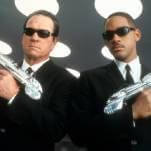From 1966 to 1973, the TV series Mission: Impossible stuck covert government agents into complicated caper plots, showing how an "Impossible Missions Force" busted up terrorist cells, mob bosses, and communist dictators by using disguises, deception, split-second timing, and switcheroos. For the first season, Steven Hill (later replaced by Peter Graves) sorted through his dossiers of available agents, nearly always settling on master of disguise Martin Landau, sexy supermodel Barbara Bain, circus strongman Peter Lupus, and guru gadgeteer Greg Morris. Then they'd all embark on an elaborate ruse that the audience at home usually had to figure out as it was happening.
Mission: Impossible had a sense of pizzazz common to the cinema of the mid-to-late '60s, though relatively new to television. A good portion of each episode relied on images instead of dialogue, and between the subjective camerawork and the propulsive Lalo Schifrin score—which made even moments of nothingness seem fraught with tension—Mission: Impossible was a concentrated dose of pre-counterculture cool. Rarely have guys in short hair and neat suits seemed so genuinely hip—even when, as in the infamous season-one episode "A Cube Of Sugar," they were painfully pretending to be hooked on narcotics.
The 28 episodes on the Mission: Impossible: The Complete First TV Season set don't vary much, though there are low points like "A Cube Of Sugar" and high points like "Operation Rogosh," where the team tricks a foreign agent into believing that he's on trial for treason in his own country, in order to make him reveal his plan to poison Los Angeles' water supply. It's easy to see why Hill left after one season, since his role didn't amount to much more than retrieving each week's secret message—the one that "will self-destruct in five seconds"—and then handing off to the far more colorful agents. (Anyone would find it hard to compete with Bain's tendency to wind up wearing nothing but a wet towel.) But it's also easy to see why viewers came back week after week, for plots as finely tuned and well-sprung as a good watch.
Key features: Must've self-destructed.









































